Quantitatively Computing the Influence of Vegetation Changes on Surface Discharge in the Middle-Upper Reaches of the Huaihe River, China
Abstract
1. Introduction
2. Study Area and Data
3. Methods
3.1. Bernaola–Galavan (B–G) Segmentation Algorithm
3.2. Budyko Hypothesis
4. Results and Analysis
4.1. Trend Analysis
4.2. Mutation Analysis of the NDVI
4.3. Quantitative Analysis of Vegetation Variation Based on Streamflow Variation
5. Conclusions
6. Discussions
Author Contributions
Funding
Institutional Review Board Statement
Informed Consent Statement
Data Availability Statement
Conflicts of Interest
References
- Ji, G.; Lai, Z.; Xia, H.; Liu, H.; Wang, Z. Future Runoff Variation and Flood Disaster Prediction of the Yellow River Basin Based on CA-Markov and SWAT. Land 2021, 10, 421. [Google Scholar] [CrossRef]
- Ji, G.; Wu, L.; Wang, L.; Yan, D.; Lai, Z. Attribution Analysis of Seasonal Runoff in the Source Region of the Yellow River Using Seasonal Budyko Hypothesis. Land 2021, 10, 542. [Google Scholar] [CrossRef]
- Piao, S.L.; Wang, X.H.; Ciais, P.; Zhu, B.; Liu, J. Changes in satellite-derived vegetation growth trend in temperate and boreal Eurasia from 1982 to 2006. Glob. Chang. Biol. 2011, 17, 3228–3239. [Google Scholar] [CrossRef]
- Jackson, R.B.; Jobbágy, E.G.; Avissar, R.; Roy, S.; Barrett, D.; Cook, C.; Farley, K.; Maitre, D.; Mccarl, B.; Cook, C. Trading water for carbon with biological carbon sequestration. Science 2005, 310, 1944–1947. [Google Scholar] [CrossRef]
- Ji, G.; Song, H.; Wei, H.; Wu, L. Attribution Analysis of Climate and Anthropic Factors on Runoff and Vegetation Changes in the Source Area of the Yangtze River from 1982 to 2016. Land 2021, 10, 612. [Google Scholar] [CrossRef]
- Yan, D.; Lai, Z.; Ji, G. Using Budyko-Type Equations for Separating the Impacts of Climate and Vegetation Change on Runoff in the Source Area of the Yellow River. Water 2020, 12, 3418. [Google Scholar] [CrossRef]
- Wei, X.; Sun, G.; Liu, S.; Jiang, H.; Zhou, G.; Dai, L. The forest-streamflow relationship in China: A 40-year retrospect. J. Am. Water Resour. Assoc. 2008, 44, 1076–1085. [Google Scholar] [CrossRef]
- Lü, Y.; Zhang, L.; Feng, X.; Zeng, Y.; Fu, B.; Yao, X.; Li, J.; Wu, B. Recent ecological transitions in China: Greening, browning, and influential factors. Sci. Rep. 2015, 5, 8732. [Google Scholar] [CrossRef] [PubMed]
- Chen, C.; Park, T.J.; Wang, X.; Piao, S.; Xu, B.; Chaturvedi, R.; Fuchs, R.; Brovkin, V.; Ciais, P.; Fensholt, R.; et al. China and India lead in greening of the world through land-use management. Nat. Sustain. 2019, 2, 122–129. [Google Scholar] [CrossRef]
- Liu, Z.; Wang, H.; Li, N.; Zhu, J.; Pan, Z.; Qin, F. Spatial and Temporal Characteristics and Driving Forces of Vegetation Changes in the Huaihe River Basin from 2003 to 2018. Sustainability 2020, 12, 2198. [Google Scholar] [CrossRef]
- Liu, F.; Qin, T.; Girma, A.; Wang, H.; Weng, B.; Yu, Z.; Wang, Z. Dynamics of Land-Use and Vegetation Change Using NDVI and Transfer Matrix: A Case Study of the Huaihe River Basin. Pol. J. Environ. Stud. 2018, 28, 213–223. [Google Scholar] [CrossRef] [PubMed]
- Gao, Z.; Liu, S.; Qin, X.; Xu, L. Spatial-temporal evolution of the Normalized Vegetation Index (NDVI) in the Huai River Basin from 1999 to 2018. Pearl River 2022, 43, 1–9. (In Chinese) [Google Scholar]
- Zhang, J.; Zhang, C.; Bao, Z.; Li, M.; Wang, G.; Guan, X.; Liu, C. Effects of vegetation cover change on runoff in Huang-Huai-Hai River Basin. Adv. Water Sci. 2021, 32, 813–823. (In Chinese) [Google Scholar]
- An, G.; Hao, Z. Variation of Precipitation and Streamflow in the Upper and Middle Huaihe River Basin, China, from 1959–2009. J. Coast. Res. 2017, 80, 69–79. [Google Scholar] [CrossRef]
- Zhu, Y.; Wang, W.; Liu, Y.; Wang, H. Runoff changes and their potential links with climate variability and anthropogenic activities: A case study in the upper Huaihe River Basin, China. Hydrol. Res. 2015, 46, 1019–1036. [Google Scholar] [CrossRef]
- Yang, C.; Chen, H.; Gu, Z.; Wang, W.; Ju, J.; Chen, L.; Zhu, H. Analysis on Influencing Factors of Runoff Evolution in Typical Watershed of Upper Huaihe River—A Case Study of Bailianya Watershed. Sci. Soil Water Conserv. 2020, 18, 110–116. (In Chinese) [Google Scholar]
- Zhang, S.; Yang, D.; Jayawardena, A.W.; Xu, X.; Yang, H. Hydrological change driven by human activities and climate variation and its spatial variability in Huaihe Basin, China. Hydrol. Sci. J. 2016, 61, 1370–1382. [Google Scholar] [CrossRef]
- Ma, F.; Ye, A.; Gong, W.; Mao, Y.; Miao, C.; Di, Z. An Estimate of Human and Natural Contributions to Flood Changes of the Huai River. Glob. Planet. Change 2014, 119, 39–50. [Google Scholar] [CrossRef]
- Gao, C.; Ruan, T. The influence of climate change and human activities on runoff in the middle reaches of the Huaihe River Basin, China. J. Geogr. Sci. 2018, 28, 79–92. [Google Scholar] [CrossRef]
- Gao, C.; Lu, M.; Zhang, X.; Li, P. Response analysis of runoff to climate change in the upper reaches of Huaihe River Basin. J. North China Univ. Water Resour. Electr. Power (Nat. Sci. Ed.) 2016, 37, 28–32. (In Chinese) [Google Scholar]
- Liu, X.; Chen, M.; Wang, Z.; Zhu, S.; Cui, C.; Zhou, T. Analysis of the attribution of runoff changes in the middle and upper reaches of the Huaihe River basin. Yellow River 2020, 42, 16–22. (In Chinese) [Google Scholar]
- Ye, T.; Shi, P.; Zhong, H.; Qu, S.; Wu, H.; Shen, L. Attribution analysis of runoff change in the upper and middle reaches of Huaihe River based on Budyko hypothesis and differential equation. J. Hohai Univ. (Nat. Sci.) 2022, 50, 25–32. (In Chinese) [Google Scholar]
- Sun, S.; Wang, J.; Zhou, S.; Wang, J.; Yan, G.; Wang, H.; Bi, Z. Effects of climate and watershed characteristics on surface hydrological processes in the Huaihe River Basin. Acta Ecol. Sin. 2022, 42, 3933–3946. (In Chinese) [Google Scholar]
- Shi, Z.; Zhao, Q.; Wang, Y.; Zhang, L. Temporal and Spatial Evolution of Vegetation Cover and Its Relationship with Runoff in Yihe River Basin. Res. Soil Water Conserv. 2023, 30, 1–8. [Google Scholar]
- Gong, Z.; Feng, G.; Wan, S.; Li, J. Detection of North China and Global Climate Change Based on Heuristic Segmentation Algorithm. Acta Phys. Sin. 2006, 55, 477–484. (In Chinese) [Google Scholar] [CrossRef]
- Huang, C.; Du, M.; Li, P.; Guo, Y.; Wang, L. Study on Variation and Driving Force of Rainfall Concentration under Changing Environment. Adv. Water Sci. 2019, 30, 496–506. (In Chinese) [Google Scholar]
- Feng, G.; Gong, Z.; Dong, W.; Li, J. Research on climate mutation detection based on heuristic segmentation algorithm. Acta Phys. Sin. 2005, 54, 5494–5499. (In Chinese) [Google Scholar] [CrossRef]
- Choudhury, B. Evaluation of an empirical equation for annual evaporation using field observations and results from a biophysical model. J. Hydrol. 1999, 216, 99–110. [Google Scholar] [CrossRef]
- Yang, H.; Yang, D.; Lei, Z.; Sun, F. New analytical derivation of the mean annual water- energy balance equation. Water Resour. Res. 2008, 44, W03410. [Google Scholar] [CrossRef]
- Li, D.; Pan, M.; Cong, Z.; Zhang, L.; Wood, E. Vegetation control on water and energy balance within the Budyko framework. Water Resour. Res. 2013, 49, 969–976. [Google Scholar] [CrossRef]
- Ji, G.; Huang, J.; Guo, Y.; Yan, D. Quantitatively Calculating the Contribution of Vegetation Variation to Runoff in the Middle Reaches of Yellow River Using an Adjusted Budyko Formula. Land 2022, 11, 535. [Google Scholar] [CrossRef]
- Xu, X.; Yang, D.; Yang, H.; Lei, H. Attribution analysis based on the Budyko hypothesis for detecting the dominant cause of runoff decline in Haihe basin. J. Hydrol. 2014, 510, 530–540. [Google Scholar] [CrossRef]
- Yang, D.; Zhang, S.; Xu, X. Attribution Analysis of Runoff Change in the Yellow River Basin Based on Hydrothermal Coupling Equilibrium Equation. Sci. Sin. (Technol.) 2015, 45, 10241034. (In Chinese) [Google Scholar]
- Zhao, F.; Zhang, L.; Xu, Z.; Scott, D.F. Evaluation of methods for estimating the effects of vegetation change and climate variability on streamflow. Water Resour. Res. 2010, 46, 742–750. [Google Scholar] [CrossRef]
- Yang, Y.; Zeng, P. Effects of forest vegetation change on river runoff and sediment in China. J. Beijing For. Univ. 1994, 16, 3541. (In Chinese) [Google Scholar]
- Wu, J.; Miao, C.; Wang, Y.; Duan, Q.; Zhang, X. Contribution analysis of the long-term changes in seasonal runoff on the Loess Plateau, China, using eight Budyko-based methods. J. Hydrol. 2017, 545, 263–275. [Google Scholar] [CrossRef]
- Al-Safi, H.I.J.; Kazemi, H.; Sarukkalige, P.R. Comparative study of conceptual versus distributed hydrologic modelling to evaluate the impact of climate change on future runoff in unregulated catchments. J. Water. Clim. Chang. 2020, 11, 341–366. [Google Scholar] [CrossRef]
- Jiang, C.; Xiong, L.; Wang, D.; Liu, P.; Guo, S.; Xu, C. Separating the impacts of climate change and human activities on runoff using the Budyko-type equations with time-varying parameters. J. Hydrol. 2015, 522, 326–338. [Google Scholar] [CrossRef]
- Leuning, R.; Zhang, Y.Q.; Rajaud, A.; Cleugh, H.; Tu, K. A simple surface conductance model to estimate regional evaporation using MODIS leaf area index and the Penman-Monteith equation. Water Resour. Res. 2008, 44, 1–17. [Google Scholar] [CrossRef]
- Liu, C.M.; Wang, Z.G.; Yang, S.T.; Sang, Y.; Liu, X.; Li, J. Hydro-informatic modeling system: Aiming at water cycle in land surface material and energy exchange processes. Acta Geogr. Sin. 2014, 69, 579–587. (In Chinese) [Google Scholar]
- Zhang, D.; Liu, X.M.; Bai, P. Different influences of vegetation greening on regional water-energy balance under different climatic conditions. Forests 2018, 9, 412. [Google Scholar] [CrossRef]
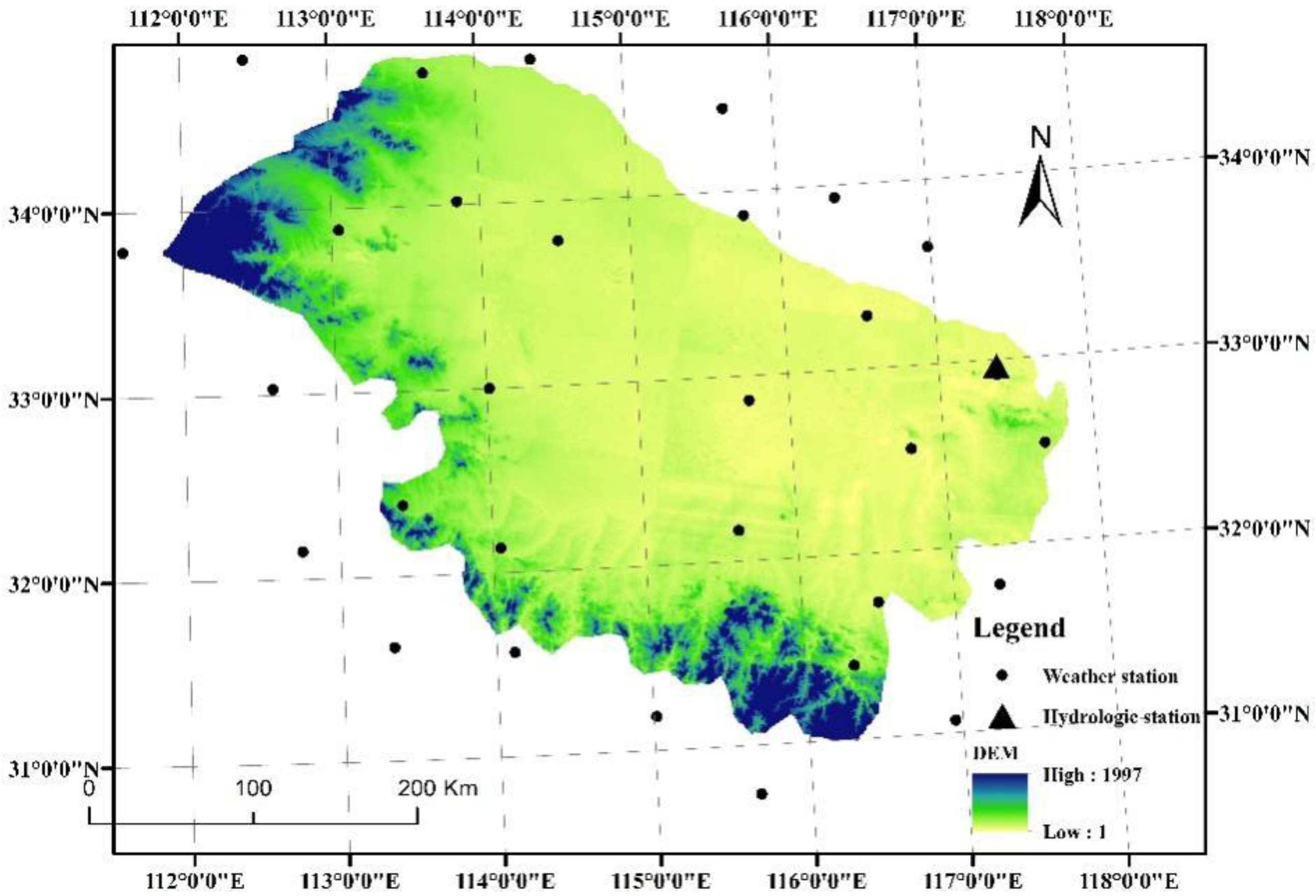
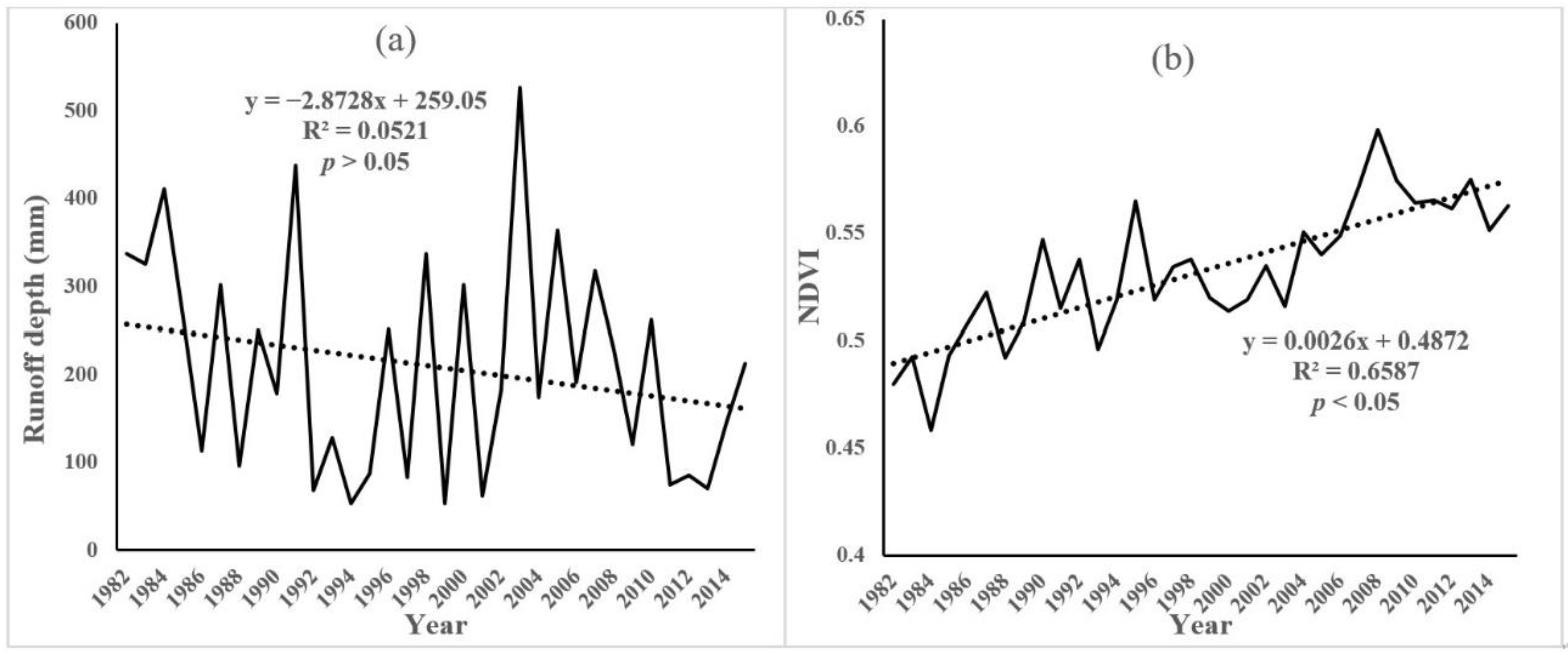
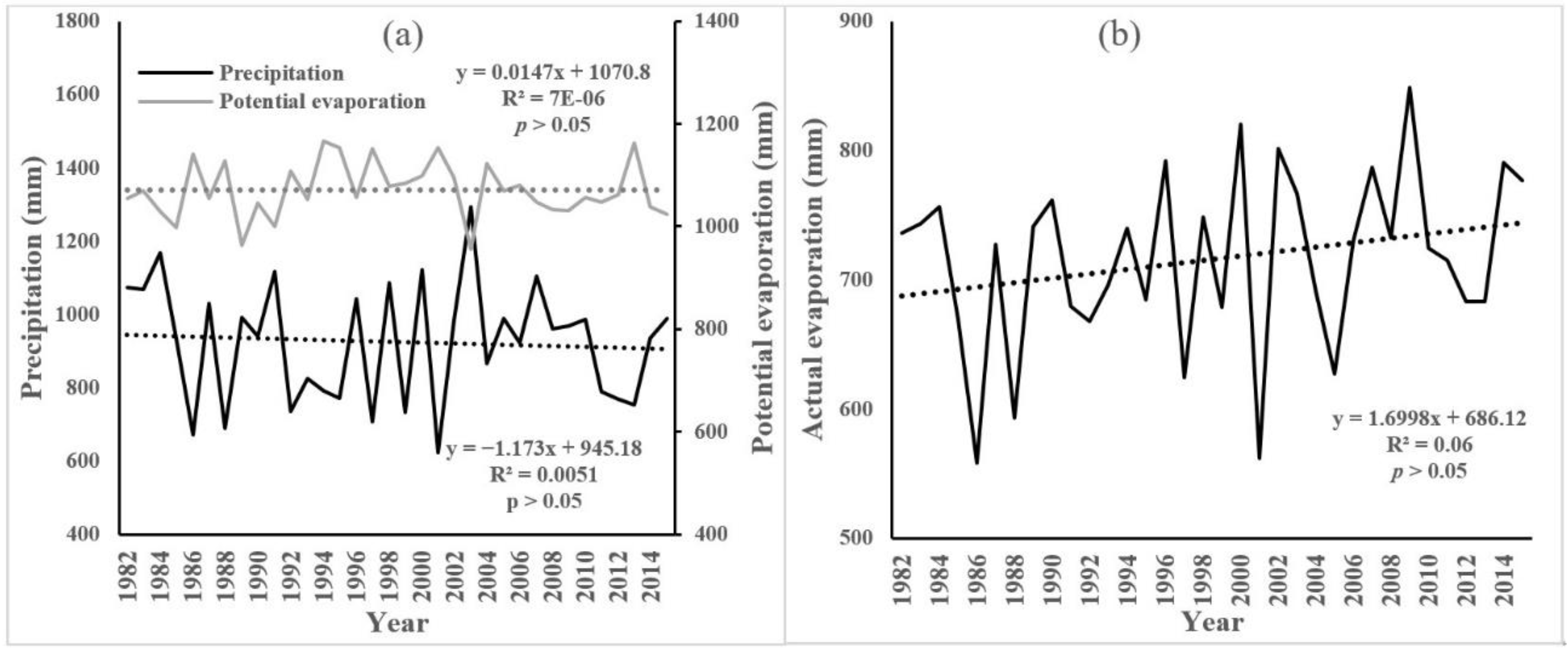
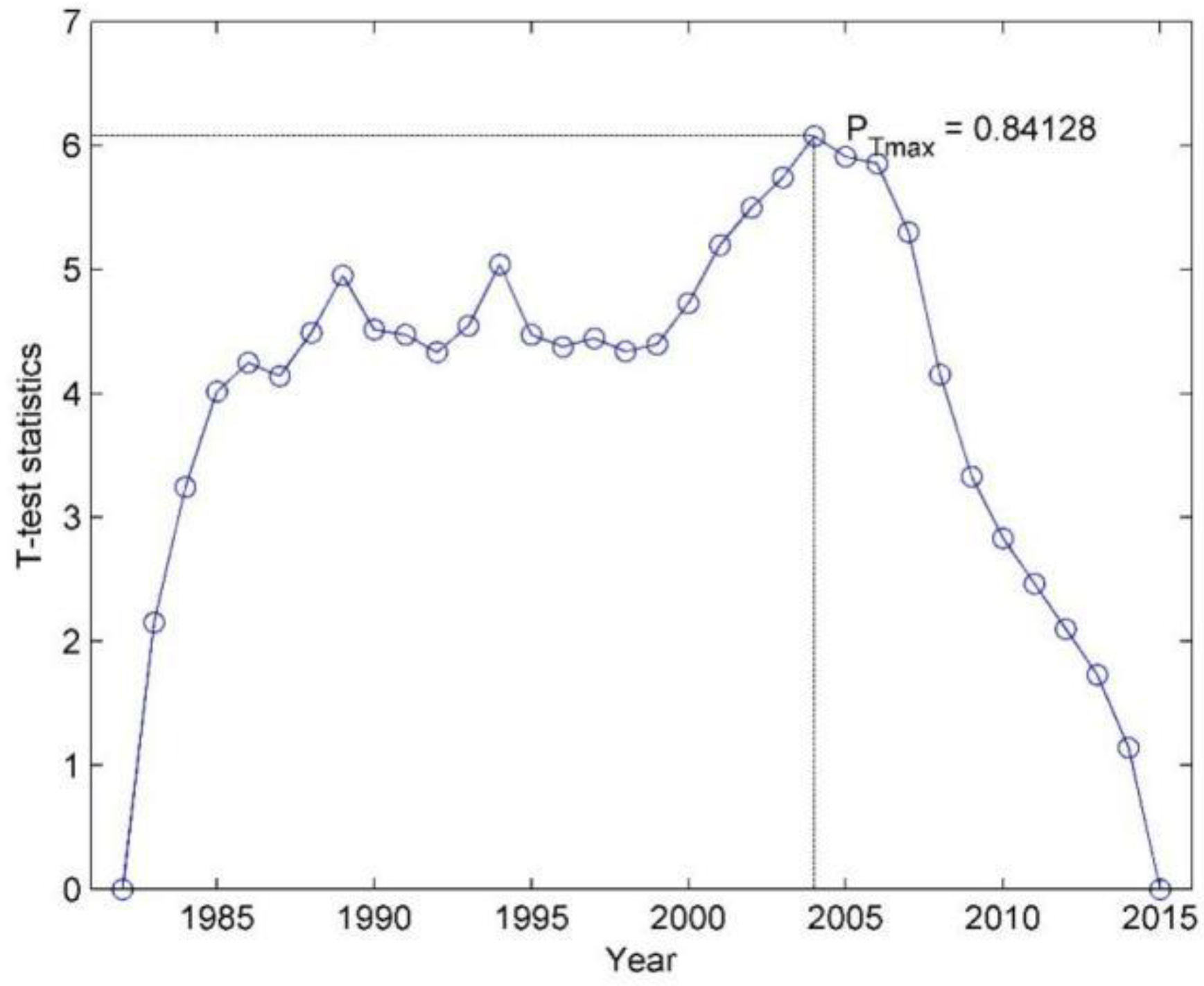
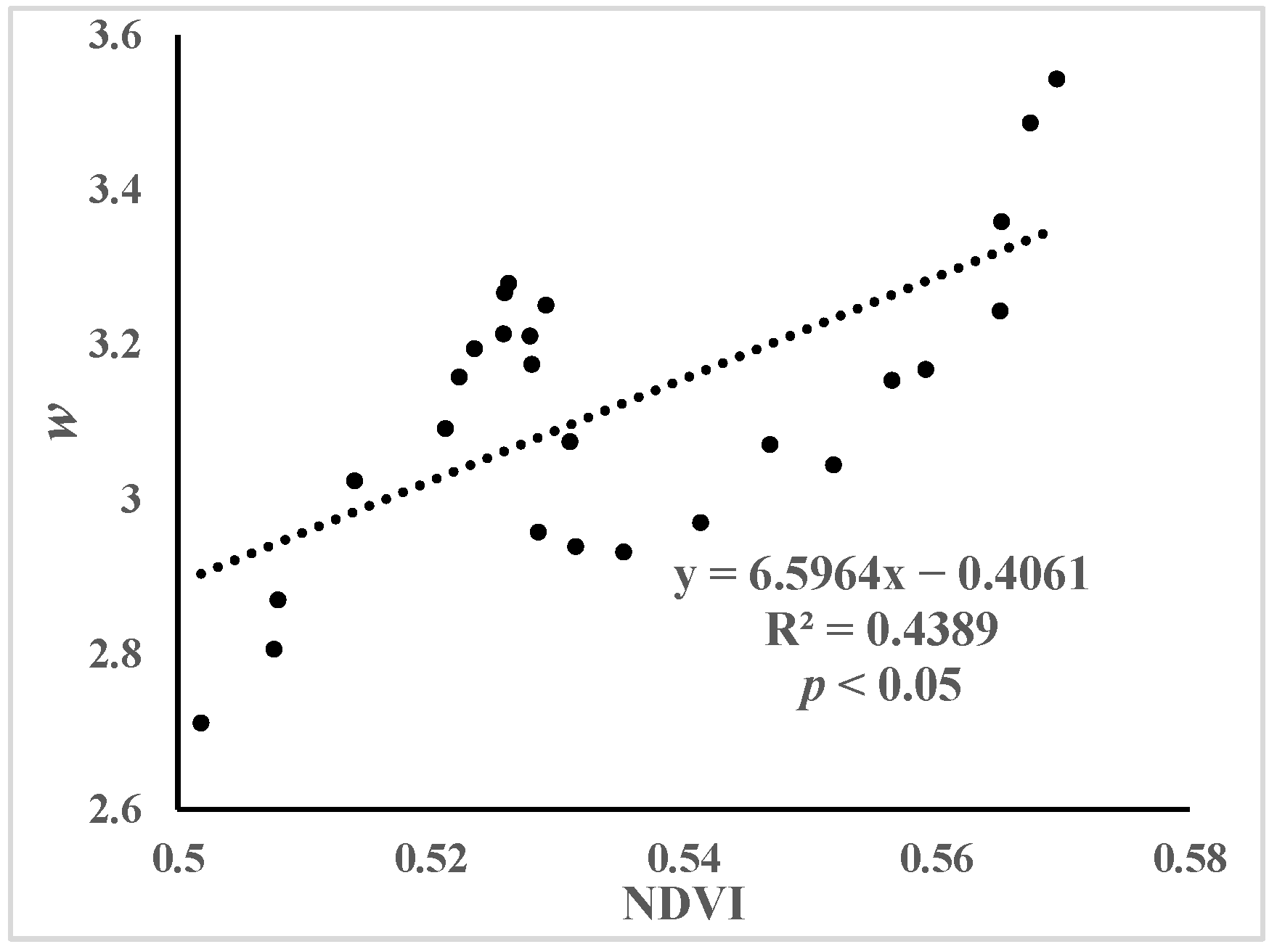
| Periods | ET0/mm | P/mm | R/mm | w | NDVI |
|---|---|---|---|---|---|
| T1 | 1076.66 | 924.59 | 218.49 | 2.74 | 0.52 |
| T2 | 1059.36 | 924.77 | 188.45 | 3.09 | 0.57 |
| Δ | −17.30 | 0.18 | −30.04 | 0.35 | 0.05 |
| εP | εE0 | εw | εNDVI | ||||||||
|---|---|---|---|---|---|---|---|---|---|---|---|
| 2.43 | −1.43 | −1.45 | −1.64 | 0.10 | 4.84 | −31.09 | −5.84 | −0.32% | −15.11% | 97.19% | 18.24% |
Publisher’s Note: MDPI stays neutral with regard to jurisdictional claims in published maps and institutional affiliations. |
© 2022 by the authors. Licensee MDPI, Basel, Switzerland. This article is an open access article distributed under the terms and conditions of the Creative Commons Attribution (CC BY) license (https://creativecommons.org/licenses/by/4.0/).
Share and Cite
Wang, Y.; Liu, Z.; Qian, B.; He, Z.; Ji, G. Quantitatively Computing the Influence of Vegetation Changes on Surface Discharge in the Middle-Upper Reaches of the Huaihe River, China. Forests 2022, 13, 2000. https://doi.org/10.3390/f13122000
Wang Y, Liu Z, Qian B, He Z, Ji G. Quantitatively Computing the Influence of Vegetation Changes on Surface Discharge in the Middle-Upper Reaches of the Huaihe River, China. Forests. 2022; 13(12):2000. https://doi.org/10.3390/f13122000
Chicago/Turabian StyleWang, Yuxin, Zhipei Liu, Baowei Qian, Zongyu He, and Guangxing Ji. 2022. "Quantitatively Computing the Influence of Vegetation Changes on Surface Discharge in the Middle-Upper Reaches of the Huaihe River, China" Forests 13, no. 12: 2000. https://doi.org/10.3390/f13122000
APA StyleWang, Y., Liu, Z., Qian, B., He, Z., & Ji, G. (2022). Quantitatively Computing the Influence of Vegetation Changes on Surface Discharge in the Middle-Upper Reaches of the Huaihe River, China. Forests, 13(12), 2000. https://doi.org/10.3390/f13122000





